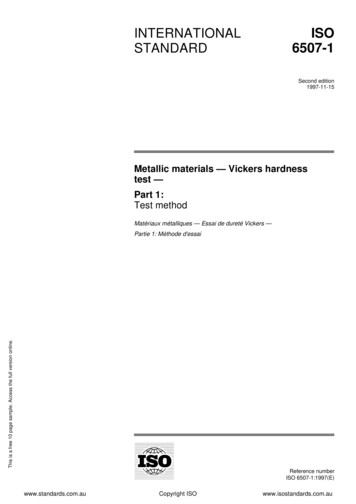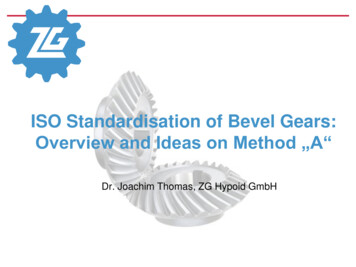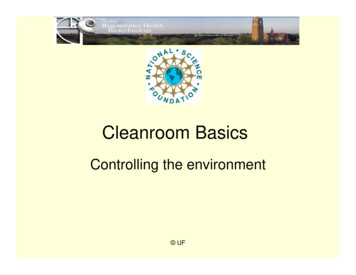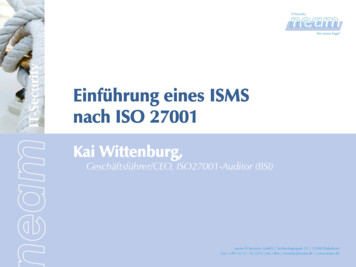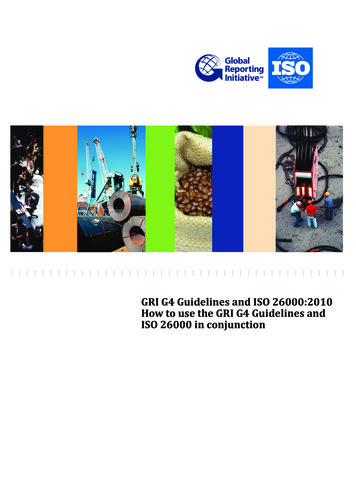
Transcription
GRI G4 Guidelines and ISO 26000:2010How to use the GRI G4 Guidelines andISO 26000 in conjunction
Legal LiabilityWhile the GRI Board of Directors encouragesthe use of the GRI Sustainability ReportingGuidelines by all organizations, the preparation and publication of reports based, completely or partially, on the GRI Guidelines isthe full responsibility of those producingthem. Neither the GRI Board of Directors, northe Stichting Global Reporting Initiative canassume responsibility for any consequencesor damages resulting directly or indirectlyfrom the use of the GRI Guidelines in the preparation of reports or from the use of reportsbased on the GRI Guidelines.Global Reporting InitiativeP.O. Box 10039NL-1001 EA AmsterdamTel: 31 20 531 00 00Fax: 31 20 531 00 31E-mail copyright@globalreporting.orgWeb www.globalreporting.orgTrademark on, the short name “ISO”,TheInternationalOrganizationfor and the ISO logo are registered tradeStandardization (ISO) and the Stichting marks of the International OrganizationGlobal Reporting Initiative (GRI) are the cop- for Standardization. Global Reportingyright owners of this document. The repro- Initiative, the Global Reporting Initiativeduction and distribution of this document for logo, Sustainability Reporting Guidelines, andinformation and/or use in preparing a sus- GRI are trademarks of the Global Reportingtainability report is permitted without prior Initiative.permission from ISO or GRI. However, neitherthis document nor any extract from it maybe reproduced, stored, translated, or transferred in any form or by any means (elec- Contributorstronic, mechanical, photocopied, recorded,or otherwise) for any other purpose without Bastian Buck, GRIprior written permission from ISO or GRI. Laura Espinach, GRIPermission can be sought at:Staffan Söderberg, ISO 26000 PostPublication Organization (PPO)ISO copyright officeISO 26000 Post Publication OrganizationCopyrightCase Postale 56CH-1211 Geneva 20(PPO)Tel: 41 22 749 01 11Fax: 41 22 749 09 47E-mail copyright@iso.orgWeb www.iso.orgPublished in January 2014 1
About the Global Reporting InitiativeThe Global Reporting Initiative (GRI) promotes the use of sustainability reportingas a way for organizations to become moresustainable and contribute to sustainabledevelopment. GRI’s mission is to make sustainability reporting standard practice. Toenable all companies and organizations toreport their economic, environmental, socialand governance performance, GRI producesfree Sustainability Reporting Guidelines. GRIis an international not-for-profit, networkbased organization. Its activity involves thousands of professionals and organizations frommany sectors, constituencies and regions.Website www.globalreporting.orgGRI Sustainability ReportingGuidelines — G4The GRI Sustainability Reporting Guidelines– the most widely used sustainability reporting framework in the world - enable all companies and organizations to report on theireconomic, environmental, social and governance performance. The fourth generation ofthe GRI Guidelines, G4, was launched in May2013 and has been revised and enhanced toreflect important current and future trendsin sustainability reporting.Sustainability reporting helps organizations toset goals, measure performance, and managechange in order to make their operationsmore sustainable. The GRI Guidelines offerReporting Principles, Standard Disclosuresand an Implementation Manual for thepreparation of sustainability reports byorganizations, regardless of their size, sectoror location. The GRI Guidelines also providean international reference for all thoseinterested in the disclosure of governanceapproach and of the environmental, socialand economic performance and impacts oforganizations. The GRI Guidelines are usefulin the preparation of any type of documentwhich requires such disclosure.2The GRI Guidelines are developed through aglobal multi-stakeholder process involvingrepresentatives from business, labor, civilsociety, and financial markets, as well asauditors and experts in various fields; and inclose dialogue with regulators and governmental agencies in several countries. The GRIGuidelines are developed in alignment withinternationally recognized reporting relateddocuments, which are referenced throughout.The G4 Guidelines have increased userfriendliness and accessibility. The emphasison what is material encourages organizationsto provide only information that is critical totheir business and stakeholders. This meansorganizations and report users can concentrate on the sustainability impacts thatmatter, resulting in reports that are morestrategic, more focused, more credible, andeasier for stakeholders to navigate.New to GRI Reporting?If you are familiar with ISO 26000 but newto the GRI Guidelines and the sustainability reporting process, GRI offers some keyresources to help you on your sustainabilityjourney.More information is available online at:http://www.globalreporting.org/
About the International Organization for Standardization (ISO)ISO is the world’s largest developerof voluntary International Standards.International Standards provide state-of-theart specifications for products, services andgood practice, helping to make industry moreefficient and effective. Developed throughglobal consensus, they help to break downbarriers to international trade.ISO 26000:2010 — Guidance on socialresponsibilityISO 26000 provides guidance on how businesses and organizations can operate in asocially responsible way. It helps clarify whatsocial responsibility is, helps businessesand organizations translate principles intoeffective actions and shares best practicesSince it was founded in 1947, ISO has published from around the world relating to socialmore than 19 500 International Standards responsibility.covering almost all aspects of technology andbusiness. From food safety to computers, from The guidance provided in ISO 26000 isagriculture to healthcare, ISO International designed to be clear and instructive, even tonon-specialists, as well as objective and appliStandards impact all our lives.cable to all types of organization, includingISO comprises a network of national stand- big business, small- and medium-sized enterards bodies representing over 160 countries prises, public administrations, governmentalfrom all regions of the world, and covering and non-govermental organizations.developed, developing and transitional economies. These national standards bodies make ISO 26000 is designed to assist organizationsup the ISO membership and each represents in contributing to sustainable development,encouraging them to go beyond basic legalISO in its own country.compliance, and to promote common underISO standards are developed through a con- standing in the field of social responsibility,sensus process by groups of experts from all complementing other instruments and initiaover the world, who are aware of the stand- tives for social responsibility.ards that are needed in their respective sectors. Because ISO standards are developed bythe people who need them and who know thesubject, they reflect a wealth of internationalexperience and knowledge.New to ISO 26000?ISO standards contribute to all three dimensions of sustainable development — economic,environmental and societal — and they drawon international consensus from the broadestpossible base of stakeholder groups. Expertinput is provided by those closest to both theimpetus for developing the standards andto the benefits of implementing them. As aresult, even though they are voluntary, ISOstandards are widely respected and implemented by public and private sectors aroundthe world.If you are familiar with the GRI Guidelines butnew to ISO 26000, ISO offers key resources tohelp you on your sustainability gement-standards/iso26000.htmPublished ISO International Standards arefrequently translated and adopted as nationalstandards by the ISO members. 3
ISO 26000 is structured as follows:ForewordIntroduction1 – Scope2 – Terms and definitions3 – Understanding social responsibility4 – Principles of social responsibility5 – Recognizing social responsibility andengaging stakeholders6 – Guidance on social responsibility coresubjects7 – Guidance on integrating social responsibility throughout an organizationAnnex A – Examples of voluntary initiativesand tools for social responsibilityAnnex B – Abbreviated termsBibliographySee Annex I for a schematic overview ofISO 26000.See Annex II for a table listing theISO 26000 core subjects and issues ofsocial responsibility.4
CONTENTIntroduction .6How does the ISO 26000 guidance relate to.8GRI’s Reporting Principles. 8Principles for Defining Report Content. 8Principles for Defining Report Quality. 10GRI’s Standard Disclosures. 10General Standard Disclosures.11Specific Standard Disclosures. 11Linkage table between GRI G4 Guidelines and ISO 26000:2010. 13Linkage table between ISO 26000:2010 and GRI G4 Guidelines. 24Annex I : Schematic overview of ISO 26000. 40Annex II : ISO 26000 core subjects and issues of social responsability. 41 5
IntroductionThis publication helps to relate the socialresponsibility guidance given in ISO 26000to the reporting guidance provided by GRI.In particular, this publication provides crossreferences between the two documents,which can be useful for all organizationsto take advantage of the synergies andcomplementarities of the two initiatives,for those organizations that have used theISO 26000 guidance and would like to reporton their social responsibility, and for thoseorganizations that follow the GRI Guidelinesto prepare their reports to understandhow GRI’s Reporting Principles, StandardDisclosures and guidance are related to theclauses of ISO 26000:2010.The first ever ISO standard on SocialResponsibility, ISO 26000, was published inNovember 20101). The standard providesguidance on the underlying principles ofsocial responsibility, recognizing socialresponsibility and engaging stakeholders, thecore subjects and issues pertaining to socialresponsibility and ways to integrate sociallyresponsible behaviour into the organization(see Annex I and II).The ISO guidance emphasizes the principle oftransparency and the value of public reportingon social responsibility performance tointernal and external stakeholders, suchas employees, local communities, investorsand regulators. This emphasis representsan important level of international attentionto the issue of reporting, and is alignedwith GRI’s mission to make sustainabilityreporting standard practice.6the two organizations related to corporatesustainability by sharing information onISO standards and GRI Guidelines, teamingup with other partners, participating in thedevelopment of new or revised documents,joint promotion and communication.In May 2013, GRI released its fourth generationof Sustainability Reporting Guidelines - G42).The latest evolution of the GRI Guidelines –part of the most widely used comprehensivesustainability reporting framework in theworld and created through an internationalmulti-stakeholder, consensus-based process3)- enables all companies and organizations toreport on their economic, environmental,social and governance performance. G4 hasbeen significantly revised and enhancedin order to reflect important current andfuture trends in the sustainability reportinglandscape.Both ISO 26000 and the GRI Guidelines have asignificant overlap and convergence in termsof the topics they cover. ISO 26000 offers acomprehensive guidance which provides astructure for companies to organize theiractivities, which can then be measured andpresented in the organization’s report byusing the GRI Guidelines.The GRI Guidelines and ISO 26000 both aim atimproving organizations’ social responsibilityand sustainability performance. It shouldbe noted that the GRI Standard Disclosuresrelated to ISO 26000 clauses should not beunderstood as the only nor the complete setof disclosures required to satisfy the scopeof each particular clause of ISO 26000:2010.GRI has actively participated in the Therefore, the full implementation of theinternational multi-stakeholder ISO 26000 GRI Guidelines should not be understooddevelopment process from the start, and as offering full or adequate compliancesupports the recognition this guidance gives on the implementation of the clauses ofto the positive contribution that businesses ISO 26000:2010.and other organizations can make throughimproved practices, to ensure a sustainable By using ISO 26000 in conjunction with theGRI Guidelines, reporters can synergizefuture for all.the two and have a practical set of toolsGRI strives for its Guidelines to harmonize to measure and report on their socialwith other reporting tools and international responsibility performance and impacts.sustainability initiatives, including ISO 26000.ISO and GRI signed a Memorandum ofUnderstanding (MoU) on 5 September 2011,to increase their cooperation for sustainabledevelopment. The MoU between ISO and 2) The GRI Guidelines are available for free downloadGRI is intended to leverage the activities of at www.globalreporting.org1) ISO 26000 http://www.iso.org/iso/iso260003) See Framework Development Process: www.globalreporting.org
Extract from ISO 26000:2010, 7.5.3, Box 15 – Reporting on social responsibility“An organization should, at appropriate intervals, report about its performance on social responsibility to the stakeholders affected.[ ]In reporting to its stakeholders, an organization should include information about its objectivesand performance on the core subjects and relevant issues of social responsibility. It should describehow and when stakeholders have been involved in the organization’s reporting on social responsibility.An organization should provide a fair and complete picture of its performance on social responsibility, including achievements and shortfalls and the ways in which the shortfalls will be addressed.[ ]Publication of a social responsibility report can be a valuable aspect of an organization’s activitieson social responsibility.”Extract from ISO 26000:2010, 7.6.2 – Enhancing the credibility of reports and claims aboutsocial responsibility“[One way] to enhance the credibility of reports [includes] making reports about performance onsocial responsibility comparable both over time and with reports produced by peer organizations[ ] and reporting conformance to the reporting guidelines of an external organization.” 7
How does the ISO 26000 guidance relate to GRI’s Reporting Principlesof the identified topics. The outcome of thisexercise is a list of material Aspects, thoseGRI’s Reporting Principles are fundamental that reflect the organization’s significantto achieving transparency in sustainability economic, environmental and social impacts,reporting and therefore should be applied or substantively influence the assessmentsby all organizations when preparing a and decisions of stakeholders. In addition,sustainability report. The Principles are the GRI Guidelines provide useful tests thatdivided into two groups: Principles for can help a reporter decide whether an issueDefining Report Content and Principles for is material.5)Defining Report Quality.Both GRI and ISO 26000 define two stepsfor identifying what are the relevant topicsPrinciples for Defining Report Contentand prioritizing the most important ones. InGRI’s Principles for Defining Report Content the first step, both standards use the termdescribe the process to be applied to identify ‘relevance’, but in the second step, GRI useswhat content the report should cover by the term ‘materiality’ while ISO 26000 usesconsidering the organization’s activities, the term ‘significance’. GRI uses the termsimpacts, and the substantive expectations ‘relevance’ and ‘materiality’ in the contextand interests of its stakeholders. There of reporting and communication to identifyare a total of four Principles: Materiality, the issues that are important enough toStakeholder Inclusiveness, Sustainability be reported on. ISO 26000 uses the terms‘relevance’ and ‘significance’ for identifyingContext and Completeness.issues to be managed, improved andcommunicated.MaterialityBoth ISO 26000 and the GRI Guidelines coverthe most common economic, environmentaland social topics and impacts that ought to beaddressed by organizations. However, whileISO 26000 is intended to give guidance on theactions and expectations for organizationsto address each of these topics, the GRIGuidelines provide guidance on what toreport for each of these topics specifically.In the context of ‘materiality’ and‘significance’, the concepts of ‘sphere ofinfluence’ in ISO 26000 and ‘boundary’ in GRIare relevant.The concept of ‘sphere of influence’in ISO 26000 is used to delineate theresponsibility of an organization over itsimpacts and it is aligned with the guidanceprovided by the UN Guiding Principles onBy following ISO 26000, “an organization Business and Human Rights.should review all the core subjects to identifyThis guidance formulates that an organizationwhich issues are relevant. The identificationis responsible for the impacts of decisionsof relevant issues should be followed byand activities over which it has formal and/oran assessment of the significance of thede facto control. In addition, an organizationorganization’s impacts. The significance of anmay in some situations have the ability toimpact should be considered with referenceaffect the behaviour of an organization withboth to the stakeholders concerned and to thewhich it has a relationship. Such situationsway in which the impact affects sustainablefall within the organization’s sphere ofdevelopment”4).influence. In ISO 26000, ‘sphere of influence’The GRI Guidelines take a similar approach is defined as the “range/extent of political,and provide extensive guidance on contractual, economic or other relationshipsidentifying and prioritizing relevant topics through which an organization has theto be included in the report, including ability to affect the decisions or activities ofguidance on how to assess the significanceof impacts and the relevance to stakeholders 5) 3.1 Principles for Defining Report Content, p. 134) ISO 26000:2010, 5.2.2812 and 4.1 General Standard Disclosures, G4-18 pp. 3139, G4 Implementation Manual
individuals or organizations”6). This meansthat the responsibility of the organization toact upon the impacts of other organizationswith which it has a relationship shouldbe determined by the extent to which theorganization’s relationship is contributingto negative impacts. An organization cannotbe held responsible for impacts of otherorganizations over which it may have someinfluence if the impact is not a result of itsdecisions and activities7).The concept of boundary in GRI is also alignedwith the UN Guiding Principles on Businessand Human Rights in the sense that if offersa framework for reporting on impacts thatthe organization has caused, contributed toor that can be linked to the organization’sactivities as a result of relationships withothers. It is important to note that theprimary use of the concept of ‘boundary’in GRI is not to assign responsibility to theorganization for the impacts that it reports on.‘Boundary’ is a concept used to simply referto the description of where impacts occur foreach relevant topic. In the GRI Guidelines, itis expected that an organization will reportsignificant impacts that occur within theorganization (i.e., within the entities thatare owned/included in the organization’sconsolidated financial statements); andoutside of the organization (i.e., impacts thatoccur elsewhere than in the entities thatare owned/included in the organization’sconsolidated financial statements)8). Impactsoutside of the organization can be describedfor sustainability reporting purposes as director indirect for some topics or as caused by,contributed to, or linked to the organizationfor others.While the concept of ‘sphere of influence’in ISO 26000 is useful for assessing theorganization’s level of responsibility forimpacts within its sphere of influence, the GRIconcept of ‘boundary’ is useful for describingwhere an organization’s impacts occur,whether within or outside of the organizationor both.6) ISO 26000:2010, 2.197) ISO 26000:2010, 5.2.3 and 7.3.38) 4.1 General Standard Disclosures, G4-18 pp. 3139, G4 Implementation ManualStakeholder InclusivenessISO 26000 introduces the principle of socialresponsibility on the “respect for stakeholderinterests”9) and indicates that informationrelating to social responsibility should be“responsive to stakeholder interests”10) andthe GRI Guidelines present the principleof Stakeholder Inclusiveness. In addition,ISO 26000 provides guidance on the natureand purpose of stakeholder engagement11),while GRI’s guidance is focused on stakeholderinclusiveness in the reporting process12).While ISO defines ‘stakeholder’ as an“individual or group that has an interest inany decision or activity of an organization”13),GRI defines ‘stakeholders’ as “entities orindividuals that can reasonably be expected tobe significantly affected by the organization’sactivities, products, and services; and whoseactions can reasonably be expected to affectthe ability of the organization to successfullyimplement its strategies and achieve itsobjectives”.Sustainability ContextThe ISO 26000 guidance states that socialresponsibility reports should ormance, products and services in thecontext of sustainable development.”14)ISO 26000 further explains the relationshipbetween social responsibility and sustainabledevelopment: “The objective of sustainabledevelopment is to achieve sustainability forsociety as a whole and the planet. It doesnot concern the sustainability or ongoingviability of any specific organization. Thesustainability of an individual organizationmay, or may not, be compatible with thesustainability of society as a whole, whichis attained by addressing social, economicand environmental aspects in an e resource use and sustainablelivelihoods are relevant to all organizations9) ISO 26000:2010, 4.510) ISO 26000:2010, 7.5.211) ISO 26000:2010, 5.312) 3.1 Principles for Defining Report Content, pp.9-10, G4 Implementation Manual13) ISO 26000, Clause 214) ISO 26000:2010, 7.5.3, Box 159
and relate to the sustainability of society asa whole.15)“to the verification as part of the report.21)Although external assurance of the report isnot a requirement to be ‘in accordance’ withGRI’s Sustainability Context Principle the GRI Guidelines, the Guidelines requiresays that a “report should present the (for those reports that have been externallyorganization’s performance in the wider assured) disclosure on the policy and practicecontext of sustainability” and guidance is regarding seeking external assurance, theprovided on how to apply this Principle in the inclusion of the external assurance statementsustainability reporting process.16)in the report and indicating in the GRIContent Index if a Standard Disclosure hasCompletenessbeen externally assured.22)ISO 26000 calls for reports to present a“complete picture of [the organization’s]performance on social responsibility”17) andGRI’s Principle of Completeness18) providesguidance for achieving this.Principles for Defining Report QualityGRI’s Principles for Defining Report Qualityguide choices on ensuring the quality ofinformation in the sustainability report,including its proper presentation. The qualityof the information is important to enablestakeholders to make sound and reasonableassessments of performance, and take GRI’s Standard Disclosuresappropriate actions. There are a total of sixPrinciples: Balance, Comparability, Accuracy, ISO 26000 calls for communication onTimeliness, Clarity and Reliability.the performance on social responsibilityof organizations23) and GRI’s GuidelinesISO 26000 indicates that information provide a comprehensive set of Standardrelating to social responsibility should be Disclosures for organizations to report onunderstandable, accurate, balanced, timely, their performance against implementingaccessible and comparable19). GRI provides ISO 26000 and against its core subjects.similar but more elaborated guidance under However, it is important to note that the GRIthe Principles of Clarity, Accuracy, Balance, Standard Disclosures related to the clausesTimeliness, and Comparability, and also adds of ISO 26000 should not be understood asthe Principle of Reliability. These Principles the only nor the complete set of disclosuresall go towards helping ensure the quality of required satisfying the scope of eachthe information included in the report.20)particular ISO clause.ISO 26000 also notes that the credibility of There are two types of GRI Standardsocial responsibility reports can be enhanced Disclosures: General Standard Disclosuresthrough third party verification or assurance, and Specific Standard Disclosures.and by publishing a statement attesting15) ISO 26000:2010, 3.3.516) 3.1 Principles for Defining Report Content, pp. 1011, G4 Implementation Manual17) ISO 26000:2010, 4.3; 7.5.2; 7.5.3, Box 15; 7.6.218) 3.1 Principles for Defining Report Content, pp. 1213, G4 Implementation Manual19) ISO 26000:2010, 4.3, 7.5.2 and 7.6.220) 3.2 Principles for Defining Report Quality, pp. 1316, G4 Implementation Manual1021) ISO 26000:2010, 7.5.3 and 7.6.222) 5.1 General Standard Disclosures, G4-32 and G433, pp. 31-36, G4 Reporting Principles and StandardDisclosures23) ISO 26000:2010, 7.5.3, Box 15
General Standard DisclosuresGRI’s General Standard Disclosures offera description of the organization and thereporting process and are applicable toall organizations preparing sustainabilityreports.The ISO 26000 guidance recommends thatthe social responsibility report describes howand when stakeholders have been involvedin the organization’s reporting on socialresponsibility, and how the organizationdecided upon the issues to be covered. 24) Inaddition, it goes on to say that “to providean informed basis for integrating socialresponsibility throughout the organization,it is useful for the organization to determinehow its key characteristics relate to socialresponsibility [ ]”, such as “the organization’stype, purpose, nature of operations and size;locations in which the organization operates;[ ] characteristics of the organization’sworkforce; [ ] [or] the organization’s ownmission, vision, values, principles, and codeof conduct”25). The GRI Guidelines offerGeneral Standard Disclosures to report onthese and other similar elements of socialresponsibility.26)Specific Standard DisclosuresThe GRI Guidelines organize SpecificStandard Disclosures into three Categories– Economic, Environmental and Social. TheSocial Category is further divided into foursub-Categories, which are Labor Practicesand Decent Work, Human Rights, Societyand Product Responsibility. The GRI Aspectsare set out within each (sub-)Category. Table1 ‘Linkage table between GRI G4 Guidelinesand ISO 26000’ gives an overview of the GRICategories and Aspects.The organization’s sustainability reportpresents information relating to materialAspects, those that reflect the organization’ssignificant economic, environmental andsocial impacts; or that substantively24) ISO 26000:2010, 7.5.3, Box 1525) ISO 26000:2010, 7.226) 5.1 General Standard Disclosures, pp. 24-42, G4Reporting Principles and Standard Disclosuresinfluence the assessments and decisions ofstakeholders.The information reported for each identifiedmaterial Aspect can be disclosed asDisclosures on Management Approach and asIndicators27).Disclosures on Management ApproachISO 26000 states that “an organization shouldconscientiously and methodically manage itsown impacts associated with each core subjectand monitor the impacts of the organizationswithin its sphere of influence”28) and that“due diligence29) can be a useful approach foran organization in addressing the issues ofsocial responsibility”30).GRI takes a similar approach by incorporatingdue diligence considerations as part ofthe Generic Disclosures on ManagementApproach. The Disclosures on ManagementApproach in the GRI Guidelines providenarrative information on how an organizationidentifies, analyzes, and responds to itsactual and potential material economic,environmental and social impacts. They alsoprovide context for the performance reportedby Indicators.The Generic Disclosures on ManagementApproach in the GRI Guidelines can be usedto explain how an organization manages a
clauses of ISO 26000:2010. The first ever ISO standard on Social Responsibility, ISO 26000, was published in November 20101). The standard provides guidance on the underlying principles of social responsibility, recognizing social responsibility and engaging stakeholders, the core subjects and issues pertaining to social





